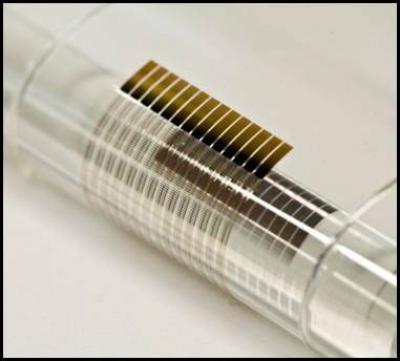A new way to make solar cells thin, efficient and flexible
December 11, 2013

A printed solar cell (credit: UCF)
Researchers from the University of Illinois at Urbana-Champaign and the University of Central Florida may be one step closer to making solar cells that operate efficiently on a large scale.
The team found a way to create large sheets of nanotextured silicon micro-cell arrays that hold the promise of making solar cells lightweight, more efficient, bendable, and easy to mass produce.
Nanoimprinting
The team used a light-trapping scheme based on a nanoimprinting technique: a polymeric (plastic) stamp mechanically embosses (prints) the nanoscale pattern onto the solar cell without involving further complex lithographic steps. This approach has led to the flexibility researchers have been searching for, making the design ideal for mass manufacturing, said UCF assistant professor Debashis Chanda, lead researcher of the study.
Previously, scientists had suggested designs that showed greater absorption rates of sunlight, but how efficiently that sunlight was converted into electrical energy was unclear, Debashis said. This study demonstrates that the light-trapping scheme offers higher electrical efficiency in a lightweight, flexible module.
Specifically, the scheme offers power-conversion efficiencies of about 8.5%, corresponding to a 190% enhancement over those of otherwise identical cells without light-trapping schemes.
The team believes this technology could someday lead to solar-powered homes fueled by cells that are reliable and also provide stored energy for hours without interruption.
“This is the first demonstration of a light-trapping scheme in functional thin-film solar cells,” Chanda told KurzweilAI. “Industrial-scale manufacturing needs further process development based on at least couple of years of funding.”
Other researchers on the project include Ki Jun Yu, Li Gao, Jae Suk Park, Yi Ri Lee, Christopher J. Cocoran, Ralph G. Nuzzo and John A. Rogers from the University of Illinois at Urbana-Champaign.
Abstract of Advanced Energy Materials paper
Debashis Chanda, John A. Rogers, and co-workers report ultrathin (3 μm) singlecrystalline silicon solar cells with electromagnetically optimized light-trapping schemes that offer greatly enhanced absorption and corresponding improvements in efficiency of cell performance. Optically optimized cells of this type yield energy conversion efficiencies that are ≈190% higher compared to otherwise identical cells that do not exploit light trapping features, and an efficiency of 8.5% is recorded in this ultrathin film geometry